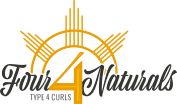Four Naturals Glossary Hair Terms

STRAND TEXTURE/THICKNESS
Hair texture is a term used to describe the thickness or width of each individual hair strand. It’s important to keep in mind that hair texture does not determine your density, or how much hair you actually have. There are three basic hair textures: fine, medium, and coarse. The easiest way to determine your own hair texture is by taking a single strand and laying it flat on a white piece of paper.
If your hair is not easy to see or feel between your fingertips, appears thin, and doesn’t hold styles well, you have fine hair texture.
If your hair is visible, not hard to feel between fingertips, appears full, and holds styles fairly well, you have medium hair texture.
Lastly, if your hair is highly visible, easily felt between fingertips, appears very full, and holds styles very well, your hair texture is considered coarse
POROSITY
The porosity of your hair affects how well oils and moisture pass in and out of the outermost layer of your hair, known as the cuticle. Essentially, hair porosity is about your cuticle’s health and ability to absorb and retain moisture. And your porosity has the ability to change due to how your hair is treated.
There are 3 porosity types: Low, Balanced and High.
The structure of a low porosity cuticle doesn’t easily allow moisture to be absorbed into the hair shaft. This can make it harder for water to saturate the hair when it’s washed.

Because this type of hair tends to repel moisture, it can also be more challenging to process and style.
High porosity hair is very porous, so water, oils, and other types of products can be easily absorbed by the hair – but doesn’t retain moisture because the cuticle’s structures have many holes and gaps.
Balanced Porosity is, well, balanced; it allows enough moisture in, while also letting the cuticle close so the hair doesn’t dry out.
You can check your porosity easily with the Water Test.
HAIR STRAND ANATOMY

Cuticle – is the outermost layer. Made of flattened cells that overlap like the tiles on a terra-cotta roof, the cuticle protects the inside of the hair shaft from damage. To feel the cuticle, just pinch a single long hair between your fingers starting up near the root.
Cortex – is a spongy substance located between the hair cuticle and medulla and is the thickest hair layer. It also contains most of the hair’s pigment, giving the hair its color. The pigment in the cortex is melanin, which is also found in skin. It consists of long keratin filaments, which are held together by disulphide and hydrogen bonds. The health of your cortex depends largely on the integrity of the cuticle protecting it
Medulla – only present in coarse/thick hair strand textures, is the innermost layer of your hair. It consists of a soft, thin core of transparent cells and air spaces. Naturally blonde and fine hair generally does not have a medulla. This nearly invisible layer is the most soft and fragile, and serves as the pith or marrow of the hair. It is the presence of a Medulla that dictates the hair width being coarse.

HAIR TYPE
Hair type is all about your hair’s curl pattern or the shape your hair strand makes. The shape your hair strand makes happens in the cortex layer of the hair strand: where all the keratin and disulphide and hydrogen bonds are located. Because the pattern of your hair is happening on a strand level, it is common to have different curl patterns or strand shapes on different parts of your head.
The most widely known and commonly accepted hair typing classification system is The Andre Walker Hair Typing System, also known as The Hair Chart. It was originally created to market Walker’s line of hair care products but has since been widely adopted as a hair type classification system. The system includes images of each hair type to aid classification. The system is split into four types with subtypes labeled A, B and C for some of the types; the system has added new subtypes since its original version to Type 1.


Note that while The Hair Chart and other such classification systems based on The Hair Chart are widely recognized among the black American public, it has not been adopted by Cosmetology Boards and is not included in formal education and training for cosmetologists. The Cosmetology Board has a “Hair is Hair” approach to testing – and then they test almost exclusively on straight Type 1 hair. This means there is no formal education on how to care for people with any pattern.










